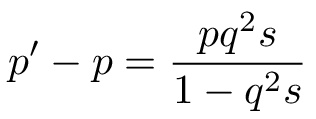
Change in the frequency of an allele in one generation.
As much as we love working in *TeX, we inevitably get stuck working in MS Office or Google Docs and have no way of making nice equations. This happened to me last fall while teaching Evolution using mostly Google Slides. Early in the semester, I found a very slick trick for quickly generating image files from TeX equations. The trick was explained in a brilliant answer by Peter Grill on StackExchange (see here).
The trick is based on a small, simple LaTeX document:
\ifdefined\formula
\else
\def\formula{E = m c^2}
\fi
\documentclass[border=2pt]{standalone}
\usepackage{amsmath}
\usepackage{varwidth}
\begin{document}
\begin{varwidth}{\linewidth}
\[ \formula \]
\end{varwidth}
\end{document}
The standalone class and varwidth environment ensure the final image will
not have unnecessary white space around your equation (see
Peter Grill’s post
for more details).
I saved the LaTeX code above to ~/texmf/tex/latex/formula.tex
and then made sure my TeX distribution could ‘see’ it by:
$ cd ~/texmf
$ mktexlsr .
Depending on your system and TeX distribution, this might be a bit different.
Next, I added the following shell script, which I named formula, to my PATH:
#!/bin/sh
if [ -z "$@" ]
then
TEX_EQUATION="p' = \frac{p}{1-q^2s}"
else
TEX_EQUATION="$@"
fi
pdflatex "\def\formula{${TEX_EQUATION}}\input{formula.tex}"
convert -density 300 formula.pdf -quality 90 formula.png
This could be modified to add some bells and whistles, like arguments to control the output format and quality, but I kept it simple.
NOTE: convert is part of
ImageMagick,
so that is required for this to work.
If you don’t already have
ImageMagick,
you should go install it right now, because it’s awesome, as
I’ve talked about in
previous posts
Now, I can simply type
$ formula "p(\theta|D) = \frac{p(D|\theta) p(\theta)}{\int p(D|\theta)p(\theta)\,d\theta}"
and get formula.png in my current working directory that has a nice looking
rendition of Bayes’ rule.

Bayes' rule.

